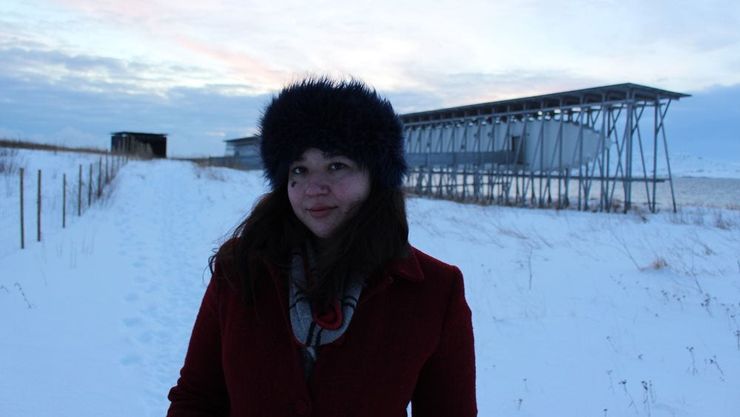The witch trials and the criminalization of female power
'It would be easy to view this story as something from the distant past, but the crux of the issue remains the same: the criminalization of women who dare to live their lives in a way men consider threatening.' Inspired by the true story behind Kiran Millwood Hargrave’s The Mercies, Naomi Frisby explores the criminalization of female knowledge and autonomy that continues today.

Pictured: The Steilneset Memorial in Vardø, Norway, commemorates the 91 people who were executed for witchcraft in 1621. It was designed by artist Louise Bourgeois and architect Peter Zumthor.
On Christmas Eve 1617 a terrible storm hit eastern Finnmark in northern Norway, and a large majority of the male population of Vardø died at sea. The church was already suspicious of Finnmark, a harsh, inhospitable and remote area where the indigenous Sami people lived amongst the Christian population. As suspicions grew, the local authorities came to believe that witches were responsible for the great storm. What followed was one of the biggest witch trials in Scandinavia.
Kiran Millwood Hargrave’s stunning debut adult novel The Mercies was inspired by the true events of the Vardø storm and the subsequent witch trials of 1621.
The Mercies tells the story of the women of Vardø through the voices of Maren, a young woman who has lost her father, brother and fiance in the storm and is now living an unexpectedly independent life, and Ursa, the young and inexperienced bride of the religious warden sent to bring 'order' back to Vardo. Here, Naomi Frisby explores how fear of women’s increasing knowledge and self-reliance led to a campaign of persecution in 1620s Vardø, and draws parallels with the treatment of women who dare to exert their autonomy today.
‘It doesn’t matter what I am, only what they believe I am.’
— Kirsten Sørensdatter in Kiran Millwood Hargrave's, The Mercies
In The Mercies, Kiran Millwood Hargrave takes the true story of the island of Vardø and allows us to experience it through the eyes of Maren, one of Vardø’s women, and Ursa, the wife of the Commander who is sent to police the village.
The novel begins on Christmas Eve, 1617, when a freak storm at sea kills the men of Vardø. Left to fend for themselves or die, the women slowly begin to take on the roles previously filled by their husbands, sons and brothers. They are led by Kirsten Sørensdatter, someone who the rest of the village sees ‘as a woman apart’. Kirsten strides about wearing trousers, clearing paths in the snow, restacking and lighting fires, caring for and slaughtering the village’s herd of reindeer, and talking to and trading with the sailors who come to the harbour. It is Kirsten who leads fishing expeditions six months after the deaths of the men when the women are gaunt and starving. Soon the women ‘have a system […] All of them have their skills, their uses’ and Maren identifies that there has been a shift. She feels ‘more consumed by her work’ than the sermons of the local pastor.
That the lifestyle the women have fashioned cannot last is made clear by the arrival of Absolom Cornet, Commissioner of Vardø. Cornet’s job is to ‘rout out [the] particular evils’ of the area known as Finnmark, within which Vardø sits. Finnmark is home to the Sámi community, an indigenous population who practise wind-weaving, spirit-talking and use charms and runes. The villagers of Vardø have sought help from the Sámi to keep them safe at sea, to protect their homes from bad luck, to aid their fertility and to guide their dead men’s souls to safety. Backed by King Christian’s sorcery laws of 1618 and frightened by what he sees in Vardø, Cornet begins a witch hunt which will have devastating consequences for the women.
It would be easy to view this story as something from the distant past, but the crux of the issue remains the same: the criminalization of women who dare to live their lives in a way men consider threatening. It isn’t difficult to find recent examples of women who’ve had their lives destroyed for exerting their autonomy. In 2016, business owner and activist Gina Miller took the UK government to court to challenge the decision to invoke Article 50 and begin withdrawing from the European Union. Following Miller’s success, she was bombarded with racial abuse, threats of acid attacks and death threats. A GoFundMe campaign was established with the purpose of raising £10,000 in order to hire a hitman to kill her.
‘It would be easy to view this story as something from the distant past, but the crux of the issue remains the same: the criminalization of women who dare to live their lives in a way men consider threatening.’
In 2017, Christine Blasey Ford, a professor of psychology at Palo Alto University and a research psychologist at Stanford University, gave a sworn testimony alleging that Brett Kavanaugh sexually assaulted her at a party when she was 15 and he was 17. Ford felt it was her ‘duty as a citizen’ to speak up. Following the testimony, Ford received death threats which forced her to hire security and move house several times. She has been unable to return to her teaching post while Kavanaugh was elected to the Supreme Court of the USA.
In 2019, writer and academic, Elif Shafak was accused of obscenity for exploring difficult subjects such as child abuse and sexual harassment in her novels and placed under investigation by Turkish prosecutors. She faced sustained abuse on social media from Turkish nationalists calling for her to be imprisoned and her work to be banned. Canan Kaftancıoğlu, provincial chair of the Republican People’s Party, who has also been attacked in the media, stated, ‘they are afraid of women, of women who do not mince their words and are brave.'
In The Mercies, Absolom Cornet is afraid of what he doesn’t understand. This fear resolves into anger and violence against the women of the village. But in an expression of hope, it is women who have the final say. Early in the novel, Maren recognises the power of stories and how they can be shaped. Of the tale of the storm she says ‘it doesn’t tell how it actually was. There are ways words fall down: they give shape too easily, carelessly.’ By giving the story of Vardø to someone who recognises this, Hargrave creates a narrator who can express the complexities of the tale while reclaiming a story that has for so long been shaped by the mouths and hands of men. In doing so, she creates the possibility that women can change society’s perception of who they really are.
The Mercies
by Kiran Millwood Hargrave
On Christmas Eve 1617, a terrible storm hits the Norwegian island of Vardø. Maren Magnusdatter watches as the men of the island, including her brother, father and fiance, are wiped out, leaving the women to fend for themselves. Eighteen months later, sinister new commissioner Absolom Cornet arrives with his young wife Ursa. Ursa sees independent women for the first time in her life, and she is drawn to Maren, the young woman who helps her navigate life in this harsh new world. But Absolom is convinced that the women’s behaviour is ungodly and he must bring them to heel by any means necessary.



